Contemporary People Management: Strategies and Practices Essay - WSU
VerifiedAdded on 2022/08/11
|8
|1692
|27
Essay
AI Summary
This essay delves into the multifaceted realm of contemporary people management, emphasizing its critical role in organizational success within a globalized and dynamic environment. It begins by defining people management as a subset of human resource management, highlighting its focus on strategic, financial, and policy aspects that govern the workforce. The essay then explores the evolving landscape of people management, shaped by globalization, technological advancements, and the increasing awareness of employee rights. It discusses the importance of adapting recruitment and selection processes to identify skilled and competent candidates who can thrive in a diverse work culture. Furthermore, the essay examines the significance of understanding employee needs, aligning individual goals with organizational objectives, and fostering employee development through training and leadership. It also emphasizes the management of workplace relations, conflict resolution, and the creation of an engaged workforce. The essay concludes by underscoring the necessity of a nuanced understanding of individual needs and the application of effective people management practices to cultivate a productive and thriving work environment. The essay also references the Maslow's hierarchy of needs, Ergonomics, and the importance of designing jobs to psychologically motivate workers.
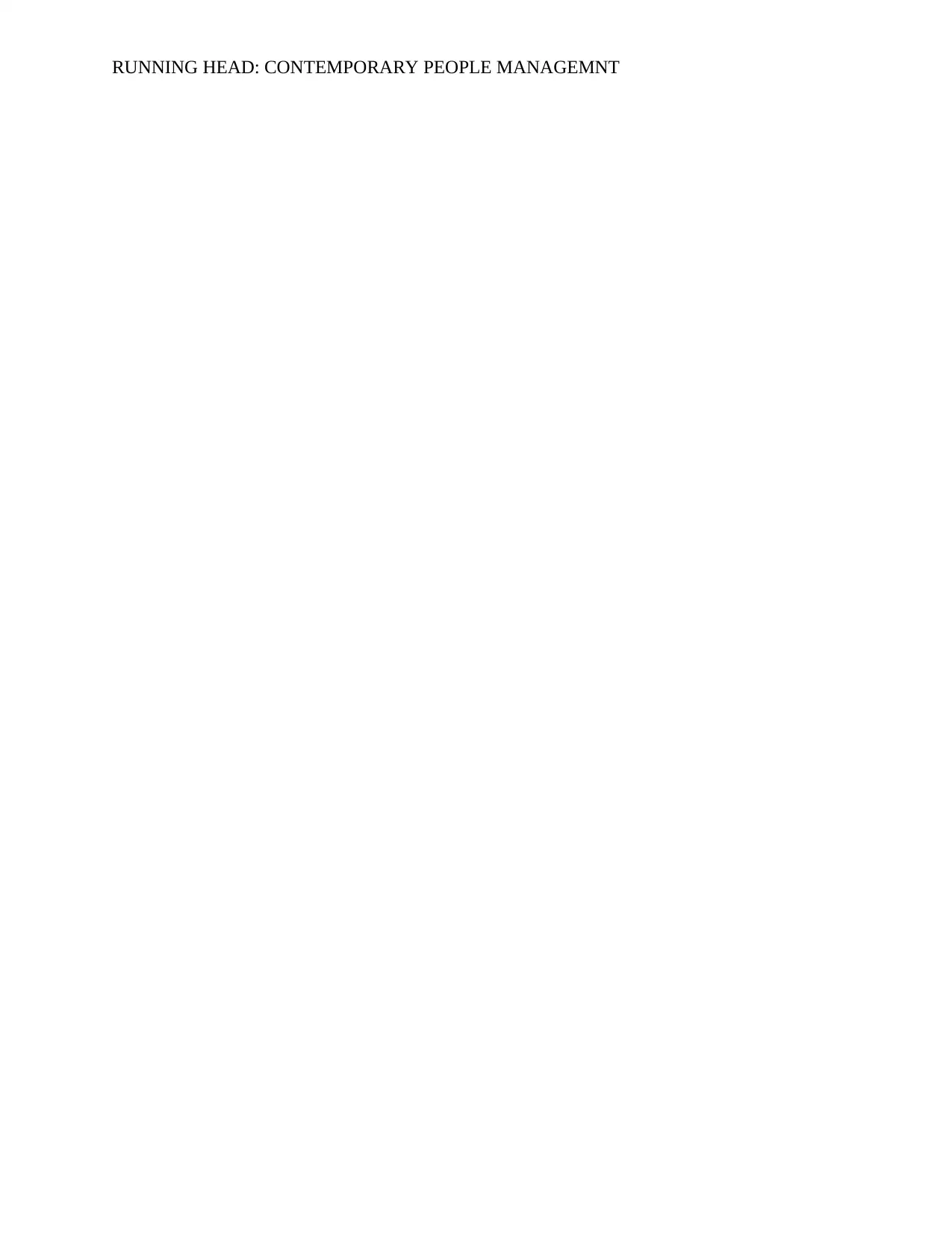
RUNNING HEAD: CONTEMPORARY PEOPLE MANAGEMNT
Paraphrase This Document
Need a fresh take? Get an instant paraphrase of this document with our AI Paraphraser
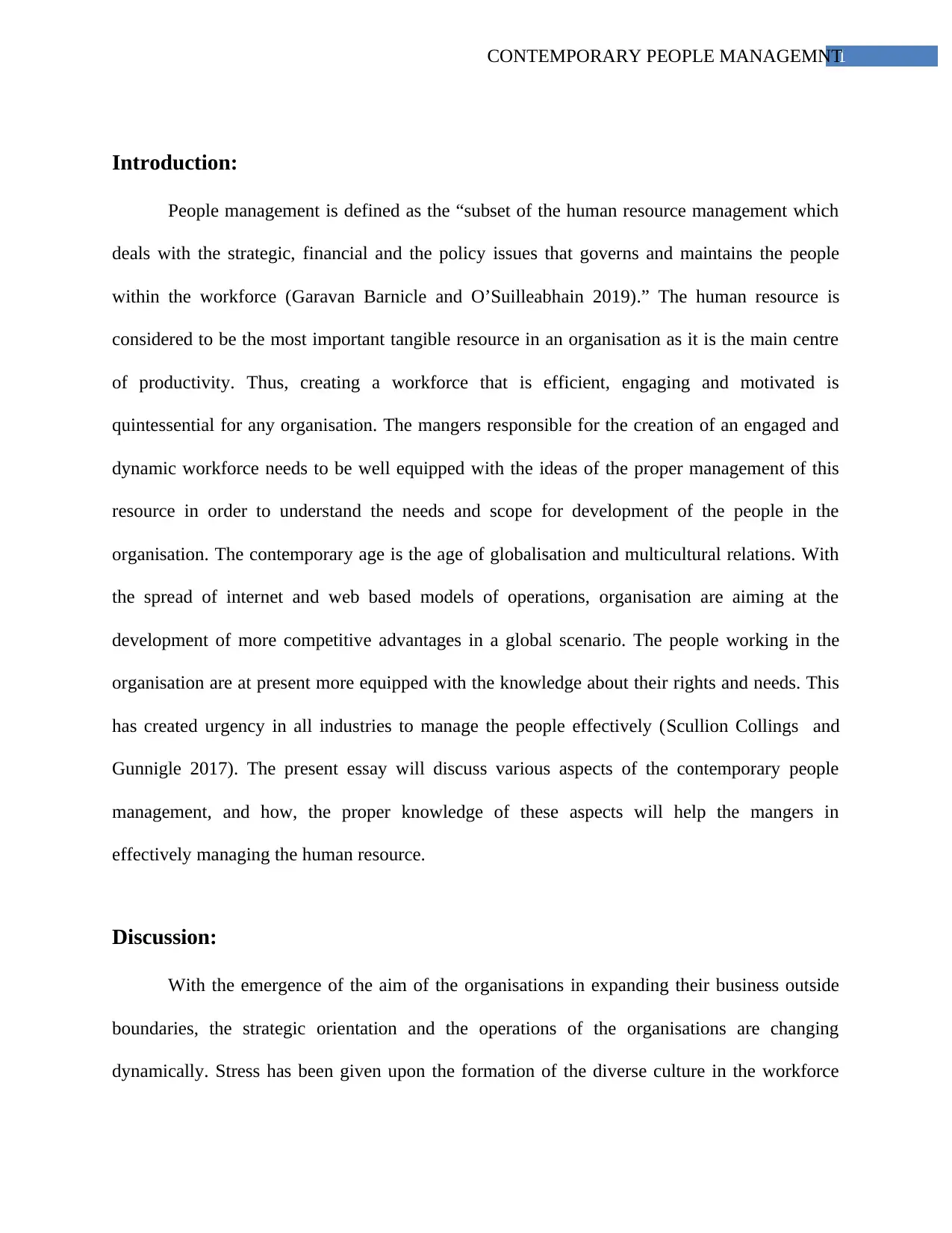
1CONTEMPORARY PEOPLE MANAGEMNT
Introduction:
People management is defined as the “subset of the human resource management which
deals with the strategic, financial and the policy issues that governs and maintains the people
within the workforce (Garavan Barnicle and O’Suilleabhain 2019).” The human resource is
considered to be the most important tangible resource in an organisation as it is the main centre
of productivity. Thus, creating a workforce that is efficient, engaging and motivated is
quintessential for any organisation. The mangers responsible for the creation of an engaged and
dynamic workforce needs to be well equipped with the ideas of the proper management of this
resource in order to understand the needs and scope for development of the people in the
organisation. The contemporary age is the age of globalisation and multicultural relations. With
the spread of internet and web based models of operations, organisation are aiming at the
development of more competitive advantages in a global scenario. The people working in the
organisation are at present more equipped with the knowledge about their rights and needs. This
has created urgency in all industries to manage the people effectively (Scullion Collings and
Gunnigle 2017). The present essay will discuss various aspects of the contemporary people
management, and how, the proper knowledge of these aspects will help the mangers in
effectively managing the human resource.
Discussion:
With the emergence of the aim of the organisations in expanding their business outside
boundaries, the strategic orientation and the operations of the organisations are changing
dynamically. Stress has been given upon the formation of the diverse culture in the workforce
Introduction:
People management is defined as the “subset of the human resource management which
deals with the strategic, financial and the policy issues that governs and maintains the people
within the workforce (Garavan Barnicle and O’Suilleabhain 2019).” The human resource is
considered to be the most important tangible resource in an organisation as it is the main centre
of productivity. Thus, creating a workforce that is efficient, engaging and motivated is
quintessential for any organisation. The mangers responsible for the creation of an engaged and
dynamic workforce needs to be well equipped with the ideas of the proper management of this
resource in order to understand the needs and scope for development of the people in the
organisation. The contemporary age is the age of globalisation and multicultural relations. With
the spread of internet and web based models of operations, organisation are aiming at the
development of more competitive advantages in a global scenario. The people working in the
organisation are at present more equipped with the knowledge about their rights and needs. This
has created urgency in all industries to manage the people effectively (Scullion Collings and
Gunnigle 2017). The present essay will discuss various aspects of the contemporary people
management, and how, the proper knowledge of these aspects will help the mangers in
effectively managing the human resource.
Discussion:
With the emergence of the aim of the organisations in expanding their business outside
boundaries, the strategic orientation and the operations of the organisations are changing
dynamically. Stress has been given upon the formation of the diverse culture in the workforce
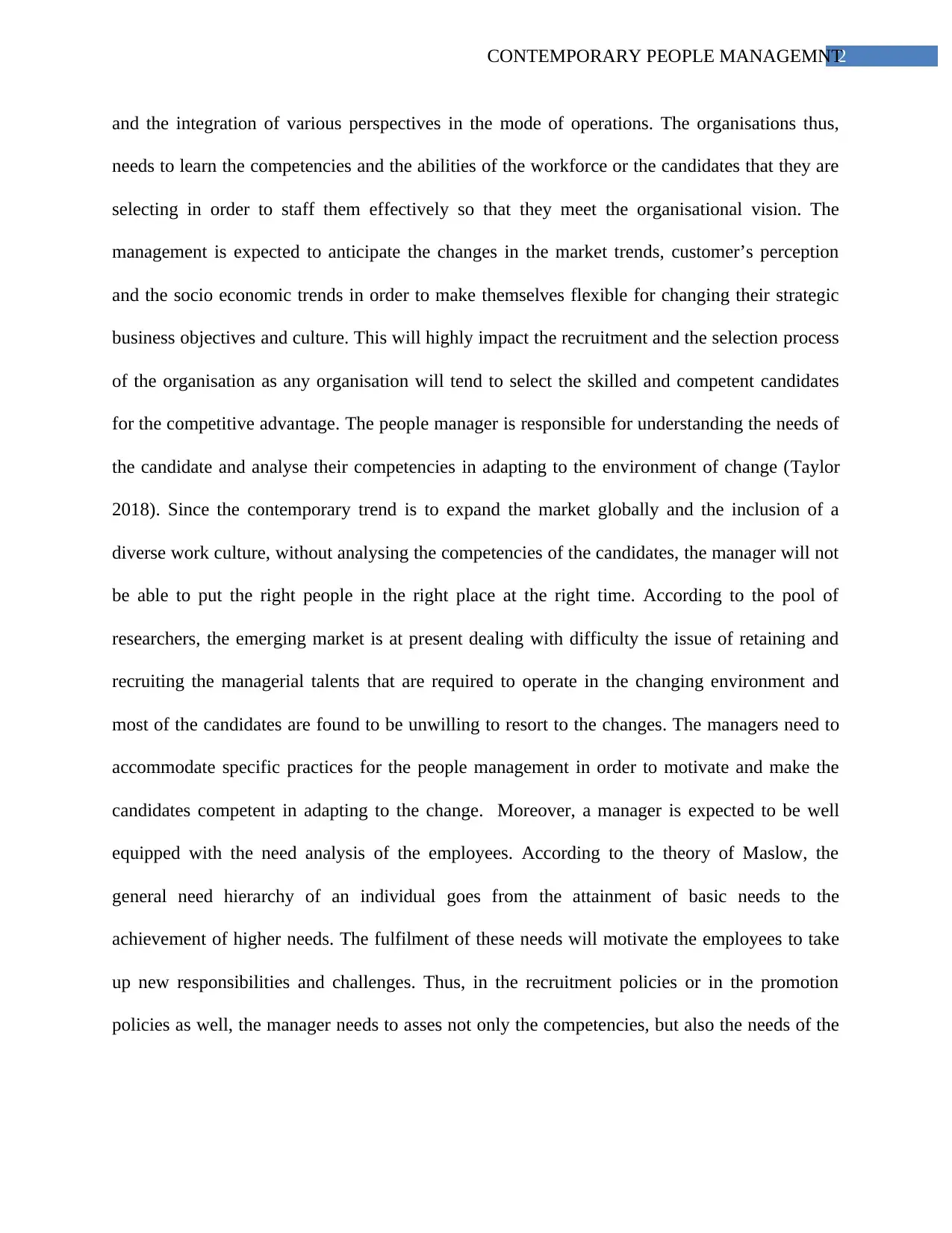
2CONTEMPORARY PEOPLE MANAGEMNT
and the integration of various perspectives in the mode of operations. The organisations thus,
needs to learn the competencies and the abilities of the workforce or the candidates that they are
selecting in order to staff them effectively so that they meet the organisational vision. The
management is expected to anticipate the changes in the market trends, customer’s perception
and the socio economic trends in order to make themselves flexible for changing their strategic
business objectives and culture. This will highly impact the recruitment and the selection process
of the organisation as any organisation will tend to select the skilled and competent candidates
for the competitive advantage. The people manager is responsible for understanding the needs of
the candidate and analyse their competencies in adapting to the environment of change (Taylor
2018). Since the contemporary trend is to expand the market globally and the inclusion of a
diverse work culture, without analysing the competencies of the candidates, the manager will not
be able to put the right people in the right place at the right time. According to the pool of
researchers, the emerging market is at present dealing with difficulty the issue of retaining and
recruiting the managerial talents that are required to operate in the changing environment and
most of the candidates are found to be unwilling to resort to the changes. The managers need to
accommodate specific practices for the people management in order to motivate and make the
candidates competent in adapting to the change. Moreover, a manager is expected to be well
equipped with the need analysis of the employees. According to the theory of Maslow, the
general need hierarchy of an individual goes from the attainment of basic needs to the
achievement of higher needs. The fulfilment of these needs will motivate the employees to take
up new responsibilities and challenges. Thus, in the recruitment policies or in the promotion
policies as well, the manager needs to asses not only the competencies, but also the needs of the
and the integration of various perspectives in the mode of operations. The organisations thus,
needs to learn the competencies and the abilities of the workforce or the candidates that they are
selecting in order to staff them effectively so that they meet the organisational vision. The
management is expected to anticipate the changes in the market trends, customer’s perception
and the socio economic trends in order to make themselves flexible for changing their strategic
business objectives and culture. This will highly impact the recruitment and the selection process
of the organisation as any organisation will tend to select the skilled and competent candidates
for the competitive advantage. The people manager is responsible for understanding the needs of
the candidate and analyse their competencies in adapting to the environment of change (Taylor
2018). Since the contemporary trend is to expand the market globally and the inclusion of a
diverse work culture, without analysing the competencies of the candidates, the manager will not
be able to put the right people in the right place at the right time. According to the pool of
researchers, the emerging market is at present dealing with difficulty the issue of retaining and
recruiting the managerial talents that are required to operate in the changing environment and
most of the candidates are found to be unwilling to resort to the changes. The managers need to
accommodate specific practices for the people management in order to motivate and make the
candidates competent in adapting to the change. Moreover, a manager is expected to be well
equipped with the need analysis of the employees. According to the theory of Maslow, the
general need hierarchy of an individual goes from the attainment of basic needs to the
achievement of higher needs. The fulfilment of these needs will motivate the employees to take
up new responsibilities and challenges. Thus, in the recruitment policies or in the promotion
policies as well, the manager needs to asses not only the competencies, but also the needs of the
⊘ This is a preview!⊘
Do you want full access?
Subscribe today to unlock all pages.

Trusted by 1+ million students worldwide
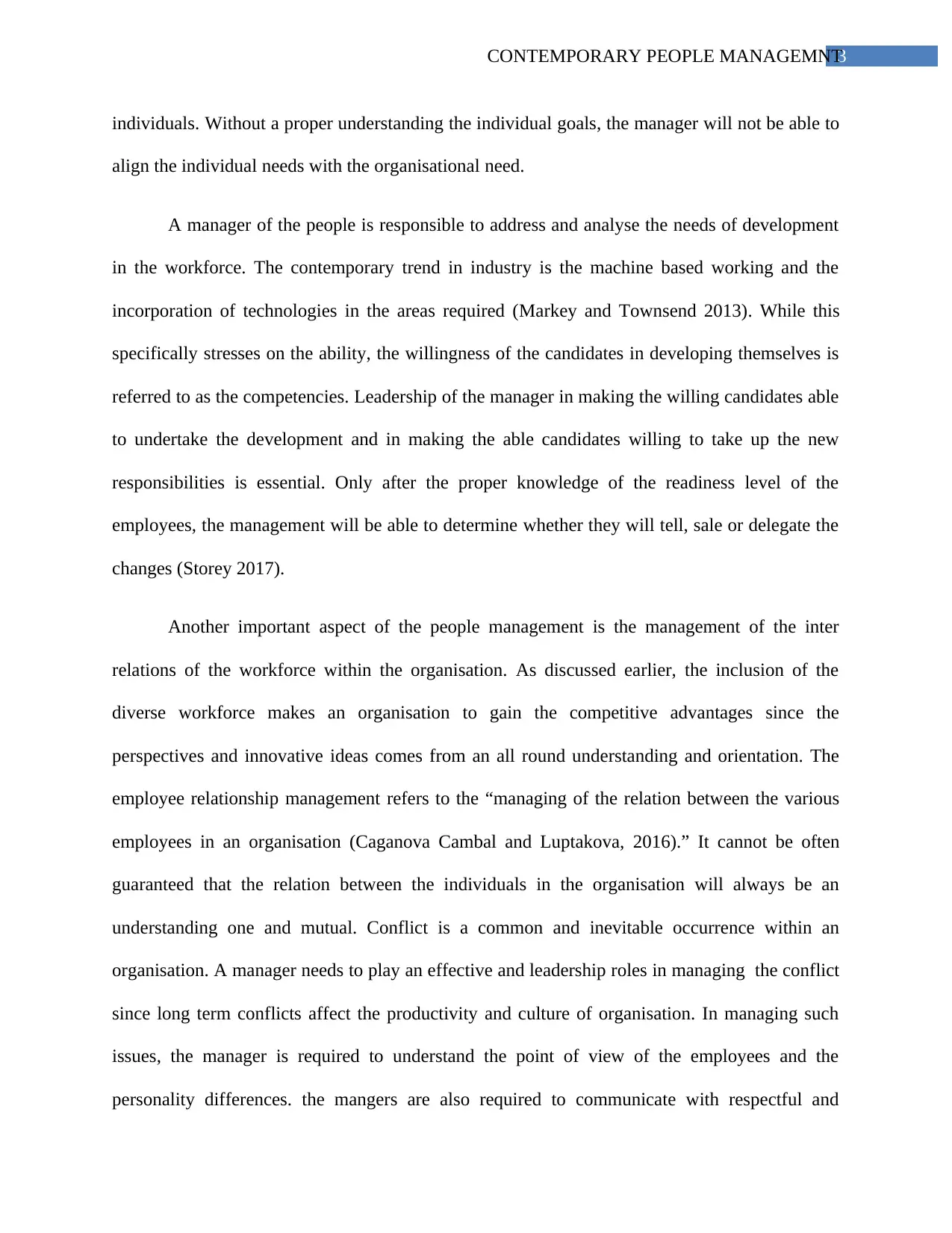
3CONTEMPORARY PEOPLE MANAGEMNT
individuals. Without a proper understanding the individual goals, the manager will not be able to
align the individual needs with the organisational need.
A manager of the people is responsible to address and analyse the needs of development
in the workforce. The contemporary trend in industry is the machine based working and the
incorporation of technologies in the areas required (Markey and Townsend 2013). While this
specifically stresses on the ability, the willingness of the candidates in developing themselves is
referred to as the competencies. Leadership of the manager in making the willing candidates able
to undertake the development and in making the able candidates willing to take up the new
responsibilities is essential. Only after the proper knowledge of the readiness level of the
employees, the management will be able to determine whether they will tell, sale or delegate the
changes (Storey 2017).
Another important aspect of the people management is the management of the inter
relations of the workforce within the organisation. As discussed earlier, the inclusion of the
diverse workforce makes an organisation to gain the competitive advantages since the
perspectives and innovative ideas comes from an all round understanding and orientation. The
employee relationship management refers to the “managing of the relation between the various
employees in an organisation (Caganova Cambal and Luptakova, 2016).” It cannot be often
guaranteed that the relation between the individuals in the organisation will always be an
understanding one and mutual. Conflict is a common and inevitable occurrence within an
organisation. A manager needs to play an effective and leadership roles in managing the conflict
since long term conflicts affect the productivity and culture of organisation. In managing such
issues, the manager is required to understand the point of view of the employees and the
personality differences. the mangers are also required to communicate with respectful and
individuals. Without a proper understanding the individual goals, the manager will not be able to
align the individual needs with the organisational need.
A manager of the people is responsible to address and analyse the needs of development
in the workforce. The contemporary trend in industry is the machine based working and the
incorporation of technologies in the areas required (Markey and Townsend 2013). While this
specifically stresses on the ability, the willingness of the candidates in developing themselves is
referred to as the competencies. Leadership of the manager in making the willing candidates able
to undertake the development and in making the able candidates willing to take up the new
responsibilities is essential. Only after the proper knowledge of the readiness level of the
employees, the management will be able to determine whether they will tell, sale or delegate the
changes (Storey 2017).
Another important aspect of the people management is the management of the inter
relations of the workforce within the organisation. As discussed earlier, the inclusion of the
diverse workforce makes an organisation to gain the competitive advantages since the
perspectives and innovative ideas comes from an all round understanding and orientation. The
employee relationship management refers to the “managing of the relation between the various
employees in an organisation (Caganova Cambal and Luptakova, 2016).” It cannot be often
guaranteed that the relation between the individuals in the organisation will always be an
understanding one and mutual. Conflict is a common and inevitable occurrence within an
organisation. A manager needs to play an effective and leadership roles in managing the conflict
since long term conflicts affect the productivity and culture of organisation. In managing such
issues, the manager is required to understand the point of view of the employees and the
personality differences. the mangers are also required to communicate with respectful and
Paraphrase This Document
Need a fresh take? Get an instant paraphrase of this document with our AI Paraphraser
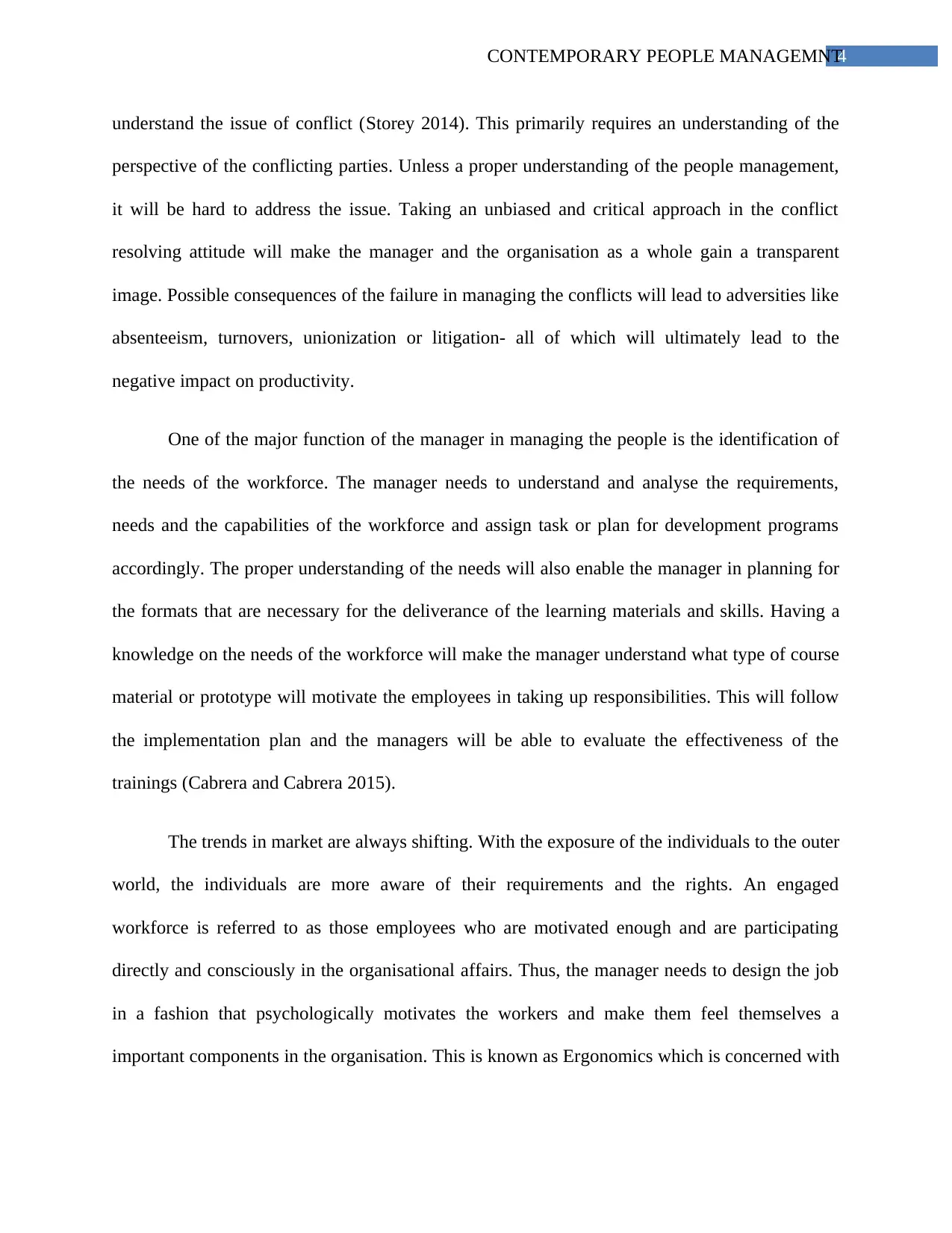
4CONTEMPORARY PEOPLE MANAGEMNT
understand the issue of conflict (Storey 2014). This primarily requires an understanding of the
perspective of the conflicting parties. Unless a proper understanding of the people management,
it will be hard to address the issue. Taking an unbiased and critical approach in the conflict
resolving attitude will make the manager and the organisation as a whole gain a transparent
image. Possible consequences of the failure in managing the conflicts will lead to adversities like
absenteeism, turnovers, unionization or litigation- all of which will ultimately lead to the
negative impact on productivity.
One of the major function of the manager in managing the people is the identification of
the needs of the workforce. The manager needs to understand and analyse the requirements,
needs and the capabilities of the workforce and assign task or plan for development programs
accordingly. The proper understanding of the needs will also enable the manager in planning for
the formats that are necessary for the deliverance of the learning materials and skills. Having a
knowledge on the needs of the workforce will make the manager understand what type of course
material or prototype will motivate the employees in taking up responsibilities. This will follow
the implementation plan and the managers will be able to evaluate the effectiveness of the
trainings (Cabrera and Cabrera 2015).
The trends in market are always shifting. With the exposure of the individuals to the outer
world, the individuals are more aware of their requirements and the rights. An engaged
workforce is referred to as those employees who are motivated enough and are participating
directly and consciously in the organisational affairs. Thus, the manager needs to design the job
in a fashion that psychologically motivates the workers and make them feel themselves a
important components in the organisation. This is known as Ergonomics which is concerned with
understand the issue of conflict (Storey 2014). This primarily requires an understanding of the
perspective of the conflicting parties. Unless a proper understanding of the people management,
it will be hard to address the issue. Taking an unbiased and critical approach in the conflict
resolving attitude will make the manager and the organisation as a whole gain a transparent
image. Possible consequences of the failure in managing the conflicts will lead to adversities like
absenteeism, turnovers, unionization or litigation- all of which will ultimately lead to the
negative impact on productivity.
One of the major function of the manager in managing the people is the identification of
the needs of the workforce. The manager needs to understand and analyse the requirements,
needs and the capabilities of the workforce and assign task or plan for development programs
accordingly. The proper understanding of the needs will also enable the manager in planning for
the formats that are necessary for the deliverance of the learning materials and skills. Having a
knowledge on the needs of the workforce will make the manager understand what type of course
material or prototype will motivate the employees in taking up responsibilities. This will follow
the implementation plan and the managers will be able to evaluate the effectiveness of the
trainings (Cabrera and Cabrera 2015).
The trends in market are always shifting. With the exposure of the individuals to the outer
world, the individuals are more aware of their requirements and the rights. An engaged
workforce is referred to as those employees who are motivated enough and are participating
directly and consciously in the organisational affairs. Thus, the manager needs to design the job
in a fashion that psychologically motivates the workers and make them feel themselves a
important components in the organisation. This is known as Ergonomics which is concerned with
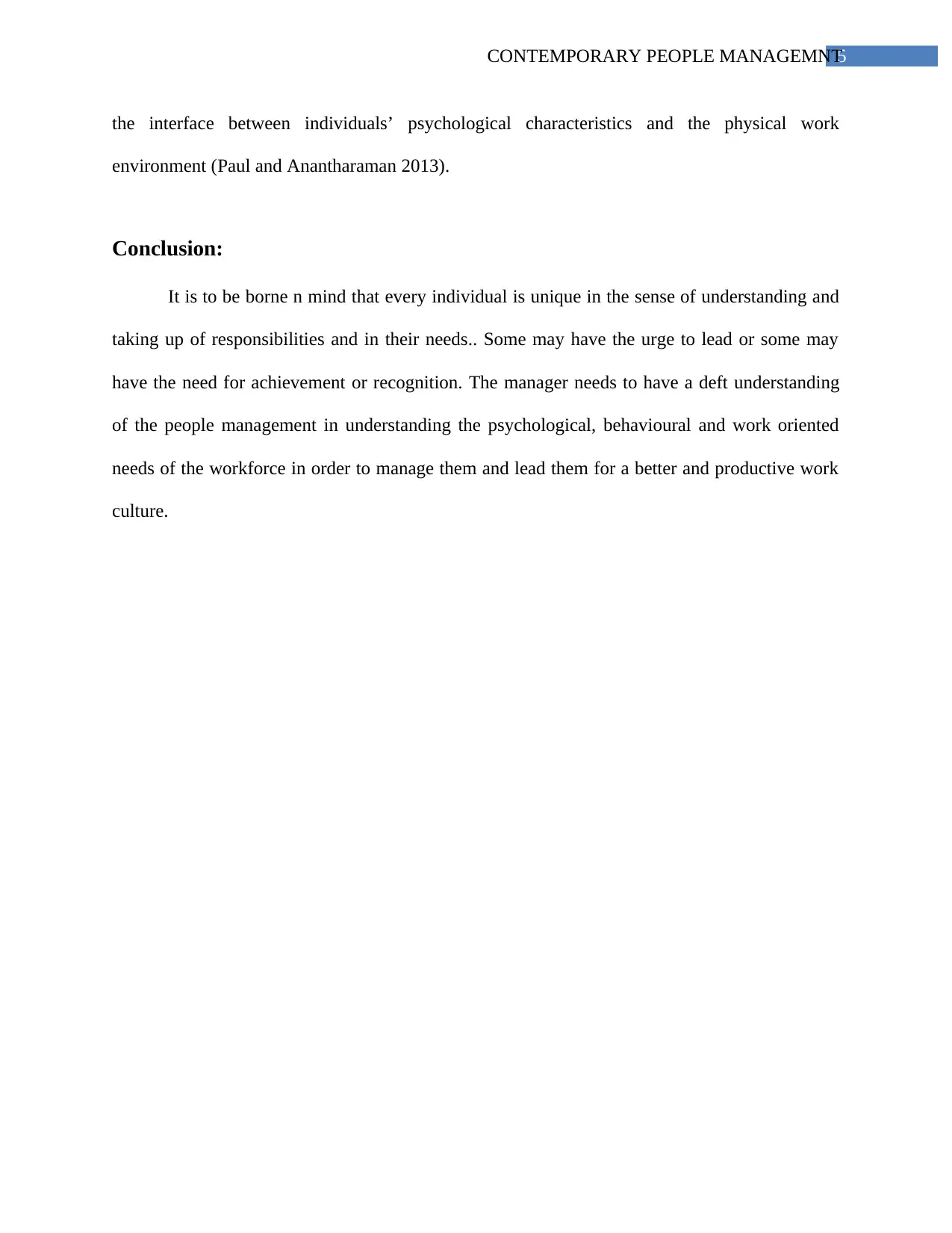
5CONTEMPORARY PEOPLE MANAGEMNT
the interface between individuals’ psychological characteristics and the physical work
environment (Paul and Anantharaman 2013).
Conclusion:
It is to be borne n mind that every individual is unique in the sense of understanding and
taking up of responsibilities and in their needs.. Some may have the urge to lead or some may
have the need for achievement or recognition. The manager needs to have a deft understanding
of the people management in understanding the psychological, behavioural and work oriented
needs of the workforce in order to manage them and lead them for a better and productive work
culture.
the interface between individuals’ psychological characteristics and the physical work
environment (Paul and Anantharaman 2013).
Conclusion:
It is to be borne n mind that every individual is unique in the sense of understanding and
taking up of responsibilities and in their needs.. Some may have the urge to lead or some may
have the need for achievement or recognition. The manager needs to have a deft understanding
of the people management in understanding the psychological, behavioural and work oriented
needs of the workforce in order to manage them and lead them for a better and productive work
culture.
⊘ This is a preview!⊘
Do you want full access?
Subscribe today to unlock all pages.

Trusted by 1+ million students worldwide
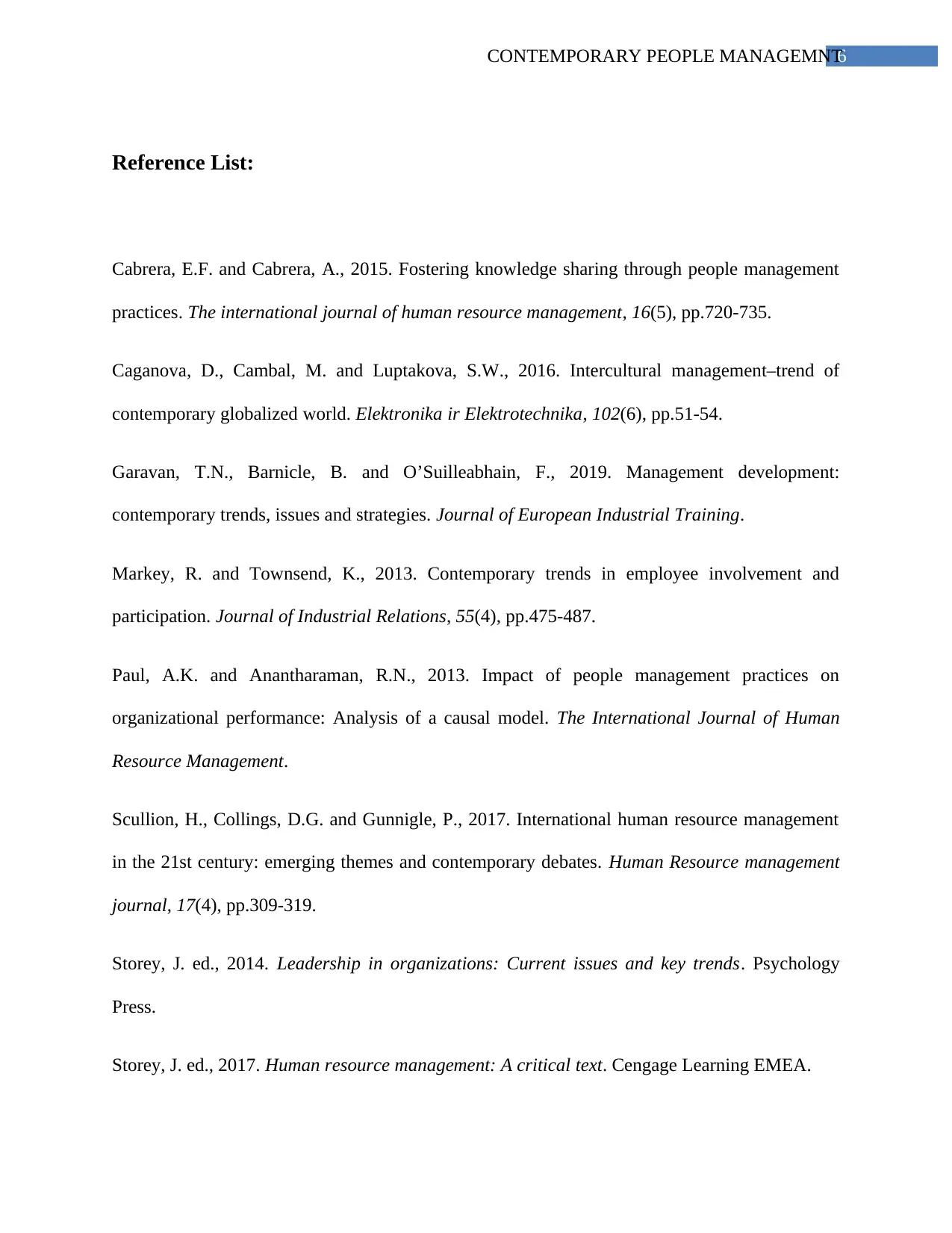
6CONTEMPORARY PEOPLE MANAGEMNT
Reference List:
Cabrera, E.F. and Cabrera, A., 2015. Fostering knowledge sharing through people management
practices. The international journal of human resource management, 16(5), pp.720-735.
Caganova, D., Cambal, M. and Luptakova, S.W., 2016. Intercultural management–trend of
contemporary globalized world. Elektronika ir Elektrotechnika, 102(6), pp.51-54.
Garavan, T.N., Barnicle, B. and O’Suilleabhain, F., 2019. Management development:
contemporary trends, issues and strategies. Journal of European Industrial Training.
Markey, R. and Townsend, K., 2013. Contemporary trends in employee involvement and
participation. Journal of Industrial Relations, 55(4), pp.475-487.
Paul, A.K. and Anantharaman, R.N., 2013. Impact of people management practices on
organizational performance: Analysis of a causal model. The International Journal of Human
Resource Management.
Scullion, H., Collings, D.G. and Gunnigle, P., 2017. International human resource management
in the 21st century: emerging themes and contemporary debates. Human Resource management
journal, 17(4), pp.309-319.
Storey, J. ed., 2014. Leadership in organizations: Current issues and key trends. Psychology
Press.
Storey, J. ed., 2017. Human resource management: A critical text. Cengage Learning EMEA.
Reference List:
Cabrera, E.F. and Cabrera, A., 2015. Fostering knowledge sharing through people management
practices. The international journal of human resource management, 16(5), pp.720-735.
Caganova, D., Cambal, M. and Luptakova, S.W., 2016. Intercultural management–trend of
contemporary globalized world. Elektronika ir Elektrotechnika, 102(6), pp.51-54.
Garavan, T.N., Barnicle, B. and O’Suilleabhain, F., 2019. Management development:
contemporary trends, issues and strategies. Journal of European Industrial Training.
Markey, R. and Townsend, K., 2013. Contemporary trends in employee involvement and
participation. Journal of Industrial Relations, 55(4), pp.475-487.
Paul, A.K. and Anantharaman, R.N., 2013. Impact of people management practices on
organizational performance: Analysis of a causal model. The International Journal of Human
Resource Management.
Scullion, H., Collings, D.G. and Gunnigle, P., 2017. International human resource management
in the 21st century: emerging themes and contemporary debates. Human Resource management
journal, 17(4), pp.309-319.
Storey, J. ed., 2014. Leadership in organizations: Current issues and key trends. Psychology
Press.
Storey, J. ed., 2017. Human resource management: A critical text. Cengage Learning EMEA.
Paraphrase This Document
Need a fresh take? Get an instant paraphrase of this document with our AI Paraphraser
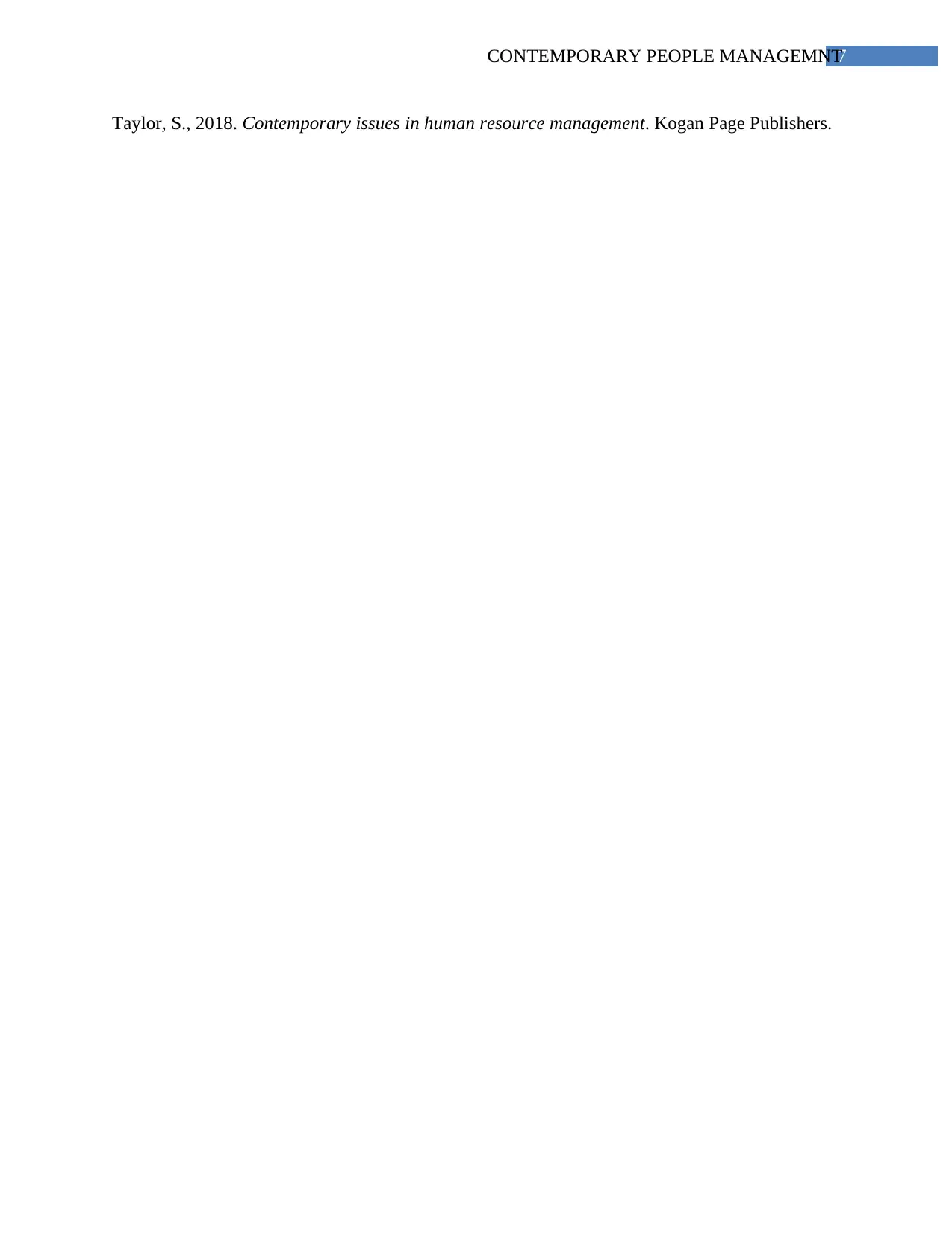
7CONTEMPORARY PEOPLE MANAGEMNT
Taylor, S., 2018. Contemporary issues in human resource management. Kogan Page Publishers.
Taylor, S., 2018. Contemporary issues in human resource management. Kogan Page Publishers.
1 out of 8
Related Documents
Your All-in-One AI-Powered Toolkit for Academic Success.
+13062052269
info@desklib.com
Available 24*7 on WhatsApp / Email
![[object Object]](/_next/static/media/star-bottom.7253800d.svg)
Unlock your academic potential
Copyright © 2020–2025 A2Z Services. All Rights Reserved. Developed and managed by ZUCOL.





